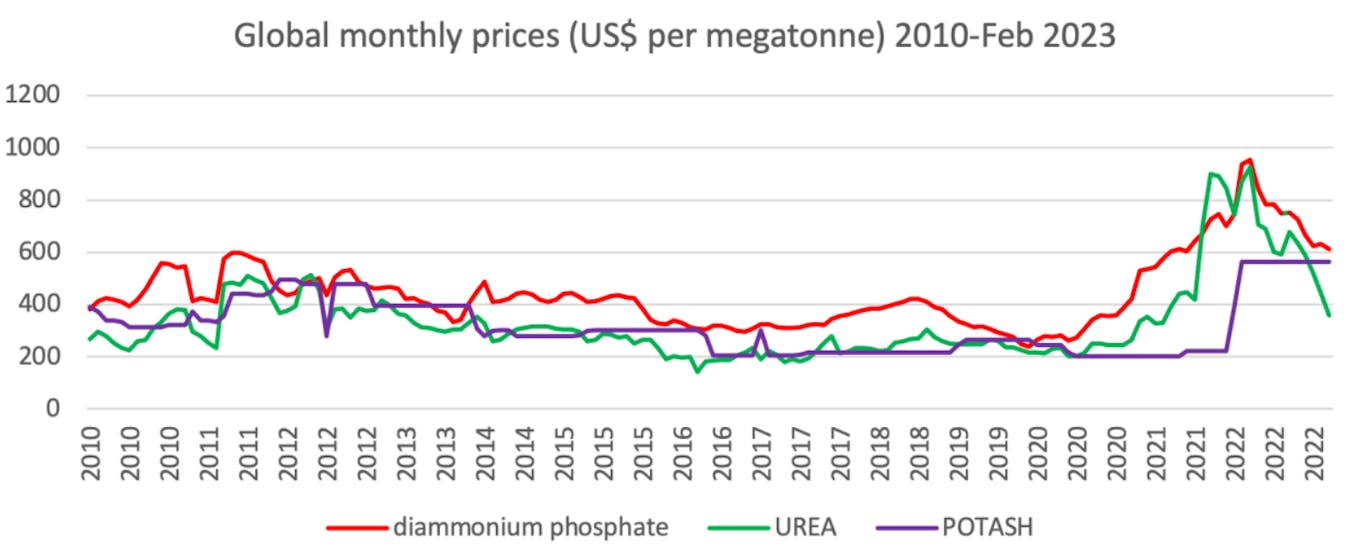Fertiliser security is key to food security. The Russia-Ukraine war that began in 2022 has caused fertiliser prices to skyrocket, due to trade sanctions on Russia and its close ally Belarus, who together account for 40 per cent of global exports of potash, along with 22 per cent and 14 per cent of ammonia and urea, respectively (see Figure 1). In response, some countries have been reorienting their fertiliser sources. For example, the Thai government recently approved the reopening of a US$1.8 billion potash mine in Chaiyaphum. Indonesia, too, just reopened a fertiliser plant in Aceh and plans another in West Papua. However, are these sufficient for Southeast Asia’s food security?

Global monthly prices of fertiliser raw materials diammonium phosphate (for nitrogen and phosphorus), urea (For nitrogen) and potash (for potassium) in US dollar per tonne, between 2010 to February 2023. Source: World Bank
Southeast Asian nations are highly dependent on external sources of fertiliser. While Indonesia is the largest importer in tonnage, Philippines, Myanmar, and Thailand imported more than 80 per cent of their fertiliser in 2020 (see table). Indonesia, Vietnam, Brunei, and Malaysia were most exposed to the Russia-Ukraine war, as more than 20 per cent of their fertiliser supply was imported from Russia and Belarus.

Fertiliser usage and imports in Southeast Asian countries in 2020. Note: Data not available for Singapore and Laos. Source: FAOSTAT
The Russia-Ukraine war was just the latest shock to fertiliser security. In reality, demand for fertiliser — mainly comprising macro–nutrients nitrogen (N), phosphorus (P) and potassium (K), or NPK —has been growing unsustainably, from 50 megatonnes annually in the 1940s to over 200 megatonnes annually by 2022 due to the increase in population and cultivation of crops requiring fertiliser.
The availability of phosphorus will be a limiting factor sooner than other fertiliser contents. It is predicted that the world will reach “peak phosphorus” in 2033, after which global production will continuously diminish. Southeast Asia has high phosphorus dependency. Myanmar, Cambodia and Brunei import 100 per cent of their phosphorus needs, while Malaysia (87 per cent), Thailand (75 per cent), Philippines (68 per cent) and Indonesia (45 per cent) are also highly dependent on global supplies. While Indonesia’s dependency rate is lower, the quantity it imports is equal to three quarters of Southeast Asia’s total phosphorus imports.
Synthetic fertiliser use has its downsides, especially increased soil acidity, heavy metals pollution, soil compaction which reduces water retention, and changes in soil microbiome, or the microorganisms growing underground. Nonetheless, it is unfeasible to wean off synthetic fertilisers entirely. Half of the world’s food production uses synthetic fertiliser. Additionally, most countries will be NPK deficient if they cease using synthetic fertilisers; their soil will be unable to support the required agricultural output.
Countries also lack mineral reserves to be self-sufficient. Nitrogen is processed from natural gas. Potassium relies on natural deposits. Phosphorus reserves are found in only a handful of countries: 75 per cent are in Morocco alone.
Fortunately, it is now possible to recover nitrogen, phosphorus, and potassium domestically through novel circular solutions that use natural sources and repurpose waste products.
Novel biofertilisers have been innovated from insect and seaweed farming. Frass from cricket and black soldier fly larvae can be administered to soil directly, and contain adequate concentrations of nutrients. Similarly, seaweed biofertiliser is rich in macro- and micro-nutrients. Both have the added benefits of improving soil and plant health, while also abetting pest and disease control.
Another promising solution derives from large-scale nutrient recovery from sewage. Human waste contains the necessary nitrogen, phosphorus, potassium, and micro-nutrients such as copper, iron, magnesium and zinc. An adult’s annual urine, for example, could fertilise 145kg of wheat. Another study has proven that medication (such as antibiotics, hormones, and others) that persists in our waste is only negligibly absorbed by our vegetables and fruits, and would not adversely affect human health when ingested.
It is in every agriculture-producing country’s best interest to shore up food security by developing localised, circular fertiliser production focused on nutrient recovery.
This is why Japan, which imports nearly all its fertilisers, has allocated 10 billion yen (US$78 million) to subsidise local municipalities for building fertiliser extraction facilities from sewage sludge. Elsewhere, companies such as Kubota (in China), Ostara (in US, Canada and Israel), Toopi Organics (in France), and Veolia (in Europe) have started large-scale extraction of fertiliser from sewage. From Northern Europe to Southern Africa, various smaller businesses have created urine collection and processing systems to collect “liquid gold”. Creating market value for sewage could promote sanitation infrastructure for the 20 per cent of urbanites and 35 per cent of rural populations in Southeast Asia that currently do not have access to modern sanitation.
With no end to the Russia-Ukraine war in sight, access to fertiliser continues to be a major vulnerability for Southeast Asia’s food security. Fertiliser production may attract a carbon price as it contributes 2.1 per cent of global greenhouse gases annually. Moreover, climate change is also expected to increase the need for fertiliser application, as elevated CO2 levels in the atmosphere reduce phosphorus retention in soils. It is thus in every agriculture-producing country’s best interest to shore up food security by developing localised, circular fertiliser production focused on nutrient recovery.
To advance, Southeast Asian nations need to invest in R&D for localised solutions, along the lines of the United States’ recently announced US$500 million in grants for this purpose. National governments could provide subsidies and incentives to local fertiliser producers. Once there is a market for localised solutions, more businesses, including sanitation operators, may invest in these nutrient recovery solutions, thereby not only contributing to fertiliser and food security, but also advancing the circular economy.
Elyssa Kaur Ludher is Visiting Fellow with the Climate Change in Southeast Asia Programme, ISEAS - Yusof Ishak Institute. Prior to joining, Ms Ludher contributed to food policy research at the World Bank, Centre for Liveable Cities Singapore, and the Singapore Food Agency.
This article was first published by ISEAS – Yusof Ishak Institute as a Fulcrum commentary.









